Dragon Quest VIII: Journey of the Cursed King (Nintendo 3DS) Review
By Rudy Lavaux  10.01.2017
10.01.2017
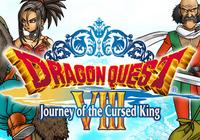
This it it; not the return of the King of Pop to prominence, but the most popular RPG series in its homeland of Japan has finally seen each and every one of its mainline entries so far released on a Nintendo system as Dragon Quest VIII: Journey of the Cursed King was the last to not have been either first released for one or ported to one in some shape or form. Moreover, this title brings European console and handheld players one step closer to finally being able to play the entire series on something other than a smart device as the original trilogy remains elusive in Europe outside of Android and iOS phones and tablets. Dragon Quest VIII is a very, if not the most, important release in the series for European players, because it was the first time a mainline entry in the series made it to the old continent, with the only previous release being Dragon Quest Monsters. It was very popular elsewhere, but just not yet here and, as such, it remains to this day by far the most popular game released here and not without good reason, considering its quality. After being so impressed by the 3DS port of Dragon Quest VII, it is, therefore, with pretty high expectations that the Nintendo 3DS version of VIII gets reviewed now…
A nameless hero, servant to his king, Trode, and daughter, Medea, both changed into a monster and a horse, respectively, travel together, accompanied by the hero's servant, Yangus, in search of Dhoulmagus who is responsible for the kind and princess' terrible fate. This very simple premise serves as the launching pad for the plot of the Journey of the Cursed King. Dragon Quest VIII opens by showcasing a very cinematic approach to storytelling, never before seen in the series. Taking in, at last, the influences of other franchises like Final Fantasy, which while it had progressed in leaps and bounds on the PSone and through the life of the PS2 up to that point, had left the Dragon Quest series feeling decidedly outdated with how Dragon Quest VII looked and felt when it came out late into the life cycle of Sony's original system. This is still a very "Dragon-Quest" game in its style and feel, though. The story may be presented better than ever, giving it a more modern and up-to-date feel than any Dragon Quest game that came before it, but the humour, the light-hearted feel, the themes touched upon, the naming conventions and traditional enemies (although the latter do not get in the way of the introduction of a lot of new ones), all spell "Dragon Quest." Fans will definitely feel right at home: it's still the same series with the same distinctive feel, which is something that Yuji Horii has been exceedingly consistent at maintaining and something that its most devoted fans over in Japan have been very content with over the last 30 years.
Players are sent into a vast open 3D world that looks very impressive on the 3DS hardware. The adventure consists of exploring vast plains, caves, dungeons, towers and all the usual Dragon Quest locations necessary for a good classic RPG, fighting monsters as they go in turn-based battles that look as dynamic as Dragon Quest could get. Indeed, the camera now rotates around characters as they perform their attacks, spells, or abilities. Speaking of the latter, Dragon Quest VIII introduces skill points that allow each character's proficiency with certain weapon types to be increased. Those are obtained with each level-up (which, as would be expected, are in turn achieved through gaining experience from defeating monsters in battle) and can either be used on the spot, or left to be attributed to weapon types at any other given time through a dedicated menu. Adding those skill points to different weapon types for each character unlocks either stat boosts whenever that weapon type is equipped or, still in those instances, special abilities to be used with those weapons that consume MP the same way that classic Dragon Quest spells do. Another important element added to this particular entry, which DS players will remember from Dragon Quest IX, is alchemy. Consumable items, or even pieces of equipment, can be fused together in an alchemy pot, for free and at any given time from a menu, to create better ones. This is a great addition that makes the experience deeper and actually finally helps to give the usual heaps of useless junk equipment that players pick from inside people's houses, drawers, and wardrobes, some actual use.
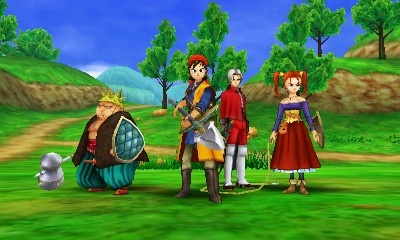
However, working fusions either have to be found at random or to be learned from recipes that are given to the players from speaking to some characters or from reading books in bookcases, another classic Dragon Quest activity that up until that point only rarely served any purpose and which is now enhanced and further encourages exploration. Dragon Quest VIII feels incredibly good as it is played thanks to all the improvements and modernisation over its predecessors that went into its making. At the centre of this experience is how big and beautiful everything looks. Characters, for the first time, bear realistic proportions and even towns seen on the world map still do keep appropriate proportions when compared the hero, which looks truly great. This vast world is not all empty, either. It holds tameable monsters, as in Dragon Quest V or VI, as well as chests placed oft-times in isolated parts of the map, encouraging exploration.
It is so big that it does take time to travel from one place to the other but, thankfully, vehicles are still present to travel the seas, and the new inclusion of the sabrecat that the hero can summon and ride upon makes travelling a lot faster. Much later in the adventure, yet another way of moving around unlocks that makes it possible to reach more places, but that will not be spoiled. The whole gives off an impression of grandeur that only the online Dragon Quest X, and the now upcoming XI, have ever surpassed, so seeing it happening on the humble 3DS is a great feat. The story is also entirely voiced over for the first time, which further enhances the feel of the world and story. This is delivered by a cast of British voice actors that usually do a great job with their lines, especially the more humorous ones, although sometimes certain voice actors, namely Jessica's, seem to struggle with the more dramatic or emotional tones.
Naturally, while this looks and sounds like something built from the ground up for the 3DS to push it to the limit, due to it looking and sounding in line or above the competition on the same platform, it is still a port of a PS2 game, and, as such, some alterations have been made. For the most part, the 3DS version looks very close to the original. It does not support stereoscopic 3D at all, so as to use all of the horsepower of an original model 3DS (this game isn't "New 3DS enhanced"). A few graphical details may be missing here and there, while other things were added like enemies now visibly roaming the map and dungeons, Dragon Quest IX-style, making battles no longer random and now avoidable. Other than that, everything looks very close. In fact, although this may be a matter of personal preference, the cel-shading used on the characters being a bit more solid and not graded brings out the classic look of Akira Toriyama characters better than in the original, looking more like actual hand-drawn anime characters.
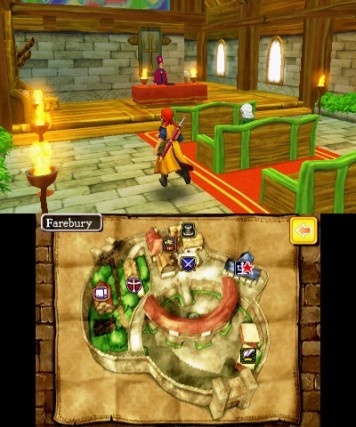
Colours, overall, are also a lot more vibrant and anime in style here than they were on the PS2. Lastly, while jaggies are no more noticeable here than in the original due to the size of the screen of the 3DS - even an XL model - when compared to a TV screen... the noticeable loss in resolution on the handheld translates to a loss in detail in very distant objects. This is something that could not have been avoided and was not unexpected, but does not take away from the experience. Everything can be examined close-up in first-person view through the eyes of the hero and the level of detail, especially for the system, is pretty high.
Outside the realm of graphics, the other immediate noticeable change is the loss of orchestrated soundtrack, present in the Western PS2 versions, as well as re-recorded for the Japanese 3DS release. This has been a bit of a sore discussion point leading up to the release outside of Japan, since the Japanese version included both a new orchestrated soundtrack and a completely new Japanese voice dub absent from the initial PS2 release. A couple things are to be considered, however, before labelling this a deal breaker. The first is that the original Japanese PS2 soundtrack, using samples, is of very high quality. It hails from the late PS2 era, so it is no more a pain for the ears than the soundtrack of other great titles of around the same time, such as The Legend of Zelda: Twilight Princess, which didn't have an orchestrated soundtrack, either. Moreover, all of the additional content added to this specific version, which had to be fit onto the card, too, had to go somewhere within the tight 4GB limit. Another fact to consider is that, for some reason, it seems that English recorded voiceover often ends up taking up more space than Japanese recorded voices. Just as Japanese text is more condensed and takes up less space when stored, English text and voices do require more storage space and this is already without accounting for the heaps of translated text for all the different languages that come on the card, as well. If the block size of the eShop release of the game is any indication, it is one of the largest games to see release on the handheld, weighing at just about the same size as Pokémon Sun and Moon at 24,000+ blocks. It does seem like everything crammed inside could not have been further compressed to make space for an orchestrated soundtrack.
What should certainly make up for this is that this specific release comes with a ton of additional content. For starters, because this is a 3DS game, the lower screen is used to display a map at all times, whether it is dungeons, villages with icons for shops and important locations, as well as the world map. Sadly, it cannot be written on to mark locations of locked chests that need to be retrieved later, which is an unfortunate missed opportunity and means the player will have to make do with the "notes" function of the 3DS, or the old pen and paper.
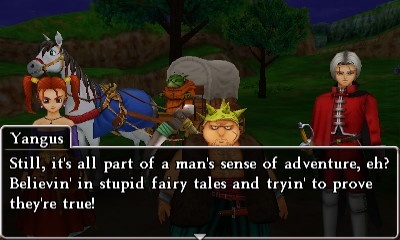
Another sizeable addition is the possibility to take pictures of anything within the game, with those pictures being saved to the SD card and importable onto a computer or other compatible device. These can be edited with filters, frames, and stickers to be "embellished." There is also a new in-game character called Cameron Obscura who gives the player missions to photograph enemies or certain other rare things using said picture functionality, adding to the whole lot of quests that the can already be taken on. Still tied to pictures is the obligatory StreetPass functionality called "StreetPass Hot Shots," allowing photos to be shared as "postcards" with other Dragon Quest VIII users, but also via the Internet apparently, although this functionality could not tested before release. Bonus items can be obtained from other StreetPass users. Also, more picture frames and stickers for sprucing pictures can also be obtained this way.
Still among the additions, because monsters are now visible on the map and inside dungeons, and battles are now avoidable, enemies that already used to carry rare monster coins are now marked with an icon over their head and can, thus, be spotted from afar, which makes collecting them for completion easier, although they serve no more purpose than being sold for money. As if all these aspects weren't enough, two characters that were NPCs in the original are now playable, which is always nice. Bonus dungeons have also been added, bringing up the longevity of the title even more. Still not enough? The main ingredient of interest in any RPG, the story, is expanded upon through new scenarios, an extra new ending and, lastly, more story-related post-ending content! Whew! With all of those elements to look forward to, players of the original should not have any reason to not want to dive in again. Granted, there will always be resolute people who consider soundtrack, or changes due to the Japanese CERO rating system being a lot stricter nowadays than in the PS2 era, to be deal breakers and enough to consider the PS2 as still the definitive version despite the heaps of new content and welcome improvements.
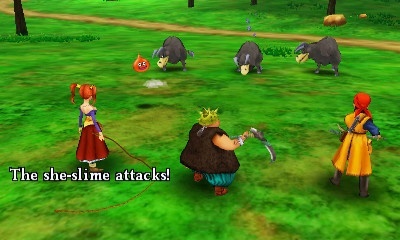
Cubed3 Rating
Exceptional - Gold Award
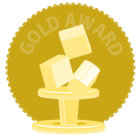
Even with its handful of changes, or regretful omissions, Dragon Quest VIII: Journey of the Cursed King on 3DS is a grandiose adventure that manages to evolve the series in terms of technical achievement and presentation, story-telling and overall convenience. It takes advantage of the enhancements of technology to help make this adventure a joy to work through, unlike some older RPGs can be nowadays. It is a definite pleasure, while still delivering the classic feel of a Dragon Quest title that most of its devoted fans, more so in Japan than anywhere else, expect to find with every new release that the series has seen to this day. Lack of orchestrated soundtrack or minimal censorship should definitely not put anyone off this historical masterpiece, even on the humble and ageing 3DS hardware. This, along with perhaps Ever Oasis, might be the last major RPG release for the system, as it probably sees its last year of relevance in 2017, and it could not hope to go out with a bigger bang than with this impressive port.
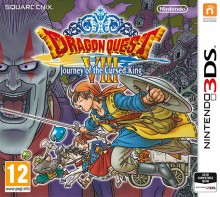
![]() 9/10
9/10
![]() 0
(0 Votes)
0
(0 Votes)
 Out now
Out now  Out now
Out now  Out now
Out now  Out now
Out now Comments
Comments are currently disabled

 Sign In
Sign In Game Details
Game Details Subscribe to this topic
Subscribe to this topic Features
Features





 Top
Top

